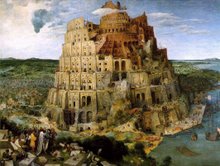
"I've been thinking a lot lately about the nature of painting."
I said this one day recently to my friend and colleague
Shawn Fields as we peered out of a fourth floor window in Chelsea. It was a luminous day, and the sun glinted off the Hudson river like a benevolent god winking. The wind paused profoundly in its journey from the west and I couldn't help but think that it had some beautiful and poetic significance.
He replied with a chuckle.
"That doesn't surprise me. What would surprise me would be if you had
stopped."
I had the feeling that I took myself altogether too seriously. So, I laughed as well and enjoyed the sun.
"So, what's new?" He asked.
Happy to embark on any conversation about art, especially with Shawn, I began with an idea that I had been molding quietly for the past year or so. I didn't know if anyone had thought it before me, had written it down, or shared it with their colleagues in a moment such as this. But, I did know that Shawn could help me mull it over.
Once I said it out loud, we both knew that it seemed so simple that we couldn't believe we'd never heard it before.
It begins with the format. Painting is static, by its nature. It does not move. It does not change with time. Its meaning is locked into a single eternal statement, and your mind must take the mold of the lock to reveal its secrets. This is both its strength and its weakness. Because of this, a painting is inherently read iconographically through layers of symbolic meaning, like an onion. So, I ventured to say that a powerful painting should reinforce this kind of iconic reading. Almost before I finished saying this Shawn had the very same question as I:
What makes a painting iconic?
So we embarked on an analysis of a multitude of paintings which represented this iconic power. One of first we brought up was Andrew Wyeth, and Shawn explained that what he thought made Wyeth's work so striking was the way he composed large regions of clear values overlapping. There was always a dark, a middle, and a light - most often another intermediary value as well. He said, that if you shrink an Andrew Wyeth down in black and white, you'll see these patterns in every single painting.
We continued on to discuss other factors that made work iconic, and what even narrative paintings like "Susan and the Elders" by Rembrandt, or "The Death of Socrates" by David, had in common with obviously iconic paintings like Goya's "Saturn". What I found was that one idea kept returning: conceptualization. Conceptualizing color, conceptualizing form, conceptualizing light....
It seemed the common element that united the iconic impact of all these artworks was how the artist filtered the content of the work through his/her ideas about form, color, light, 2-d and 3-d design, texture, etc.... And as I pondered, it all became crystal clear. Of course, it seems so obvious now, but for some reason neither of us saw it before.
Because each artist was conceiving of these elements, a little bit of the idea was passed on in each of them. It was not the subject matter, but the
way that these paintings were made that revealed the meaning, though the subject depicted could help. It was as if every single square inch of canvas was saturated with the artist's breath. His emotion, his perspective poured out of each shadow or highlight - the way he handled his brush, the decision to make a gray into blue and a hand into a silhouette, to make one detail sharper and another more obscure. There is a hierarchy and a meaning to how these elements are composed and relate to each other, which intuitively reveals meaning to the viewer. There is a mystery in this.
Film, by contrast, is a narrative form. The images change through time, in fact, it is virtually
about change. This lead me to realize that verbal language is the very definition of the narrative and this is why it is so difficult, if not impossible to truly describe a painting in words. It is much farther than translating from one language to another, one just
cannot communicate a purely visual idea in a verbal way. And one cannot communicate a verbal idea in a visual way. They are two banks over a canyon, but somehow the human mind can bridge the colossal abyss between - albeit across a dangerous and swaying rope bridge. We can see both sides, but we cannot transport anything more than a teaspoon of meaning between; hopefully not spilling its valuable contents in the unsteady journey.




